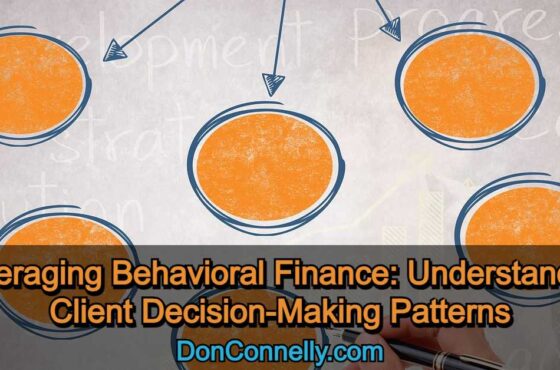Understanding Why Clients Might Seek a Second Opinion in Financial Planning and How to Avert It
 If you’ve been in this business long enough, you’re bound to encounter a client who wants to get a second opinion on some of your advice or a strategy you’ve developed. There’s no sugar-coating it—that can feel like a low blow—questioning your expertise and even your integrity.
If you’ve been in this business long enough, you’re bound to encounter a client who wants to get a second opinion on some of your advice or a strategy you’ve developed. There’s no sugar-coating it—that can feel like a low blow—questioning your expertise and even your integrity.
While it might feel like a vote of no confidence, it’s often a symptom of a deeper need. Understanding these reasons and fostering a solid client relationship can help advisors minimize the need for external validation.
Understanding the client’s perspective
Several key factors can motivate clients to seek a second opinion:
Knowledge gap and lack of clarity: Financial concepts can be complex, and clients might struggle to grasp the rationale behind investment strategies or financial products. Failing to explain the “why” clearly and concisely can leave clients confused or feeling talked down to, which can breed doubt and a desire for outside confirmation.
Risk tolerance mismatch: A client’s risk tolerance is a cornerstone of a successful financial plan. Anxiety can set in when a client’s risk appetite doesn’t align with their portfolio allocation. If the initial risk assessment wasn’t thorough or hasn’t been revisited as circumstances change, clients might seek validation of their concerns elsewhere.
Communication breakdown: Open and transparent communication is the lifeblood of any client relationship. Clients who feel their advisor isn’t responsive to their inquiries, disregards their concerns, or doesn’t communicate proactively are more likely to explore other options.
Life transitions and evolving needs: Life throws curveballs—marriage, job changes, children, and inheritance. These milestones can significantly impact a financial plan. If clients feel their advisor isn’t adapting the plan accordingly or hasn’t proactively discussed these potential life changes, they might seek an advisor who demonstrates a more forward-thinking approach.
Fees and performance concerns: Cost is a major consideration for many clients. Clients who perceive fees as excessive or feel their portfolio’s performance isn’t meeting expectations might question their current advisor and explore options with potentially lower fees or a better track record.
Second guessing and market volatility: Financial markets are inherently cyclical, and short-term fluctuations can cause anxiety. Clients might seek reassurance, especially during downturns. If advisors haven’t equipped clients with the knowledge to understand market cycles and focus solely on short-term returns, they might become vulnerable to emotional decision-making and seek outside advice.
Strategies to avert second opinions
Addressing the reasons clients seek second opinions can significantly reduce their occurrence. Here are key strategies to build trust and foster long-term client relationships:
Transparency and client education: Don’t just tell clients what to do; empower them to understand the “why.” Explain the rationale behind investment recommendations, risks, and potential outcomes. Use clear language, avoid jargon, and encourage questions. Offer educational resources to equip clients with the knowledge to make informed decisions.
Client-centric approach: Remember, it’s the client’s financial future, not yours. Prioritize understanding their unique circumstances, including their financial goals, risk tolerance, income, and expenses. Tailor recommendations to their specific needs, not a generic template.
Open communication is vital: Maintain regular contact, respond promptly to inquiries, and actively listen to client concerns. Be approachable and available through multiple communication channels (phone, email, video conferencing). Schedule regular meetings to discuss progress and address any anxieties before they escalate.
Setting realistic expectations: Don’t overpromise or guarantee unrealistic returns. Focus on long-term strategies and educate clients about market volatility. Explain how different factors can impact returns and the importance of staying disciplined through market cycles.
Regular reviews and proactive planning: Schedule regular meetings, not just when the market dips. Proactively discuss upcoming milestones like retirement, inheritance, or potential career changes and how they might necessitate adjustments to the financial plan. This demonstrates your commitment to their long-term success.
Transparent performance reporting: Provide clients with clear and concise performance reports that outline progress towards their goals. Explain investment results and align them with the client’s risk tolerance and objectives.
Competitive fees and fee transparency: Be upfront about your fees and how they are structured. Ensure your fees are competitive and offer different fee structures (e.g., hourly, retainer, asset-based) to cater to various client needs.
Building relationships, not just portfolios: Financial planning is a long-term partnership. Take time to develop rapport with your clients. Get to know them as individuals and understand their values and priorities. Building trust goes beyond numbers; it fosters mutual respect and understanding.
Conclusion
Clients seeking second opinions are not necessarily a reflection of poor service. By focusing on clear communication, client-centric planning, and building trust, advisors can minimize the need for external validation and foster long-term, successful client relationships. Remember, your clients are entrusting you with their financial well-being. By prioritizing their needs and encouraging open communication, you can become an invaluable partner on their financial journey.
Watch this 3-minute video to learn how our 24-step training program can help you ignite your performance and take your business to new heights!
See program details and enroll today!
Available as a self-paced program (always open) or as a 12-week coaching program (open only a couple of times a year), this training will change the way you view your practice and will give you an enormous advantage over your competition. Select your format and enroll now!



